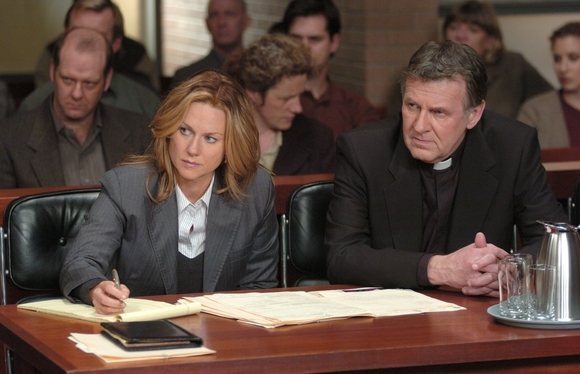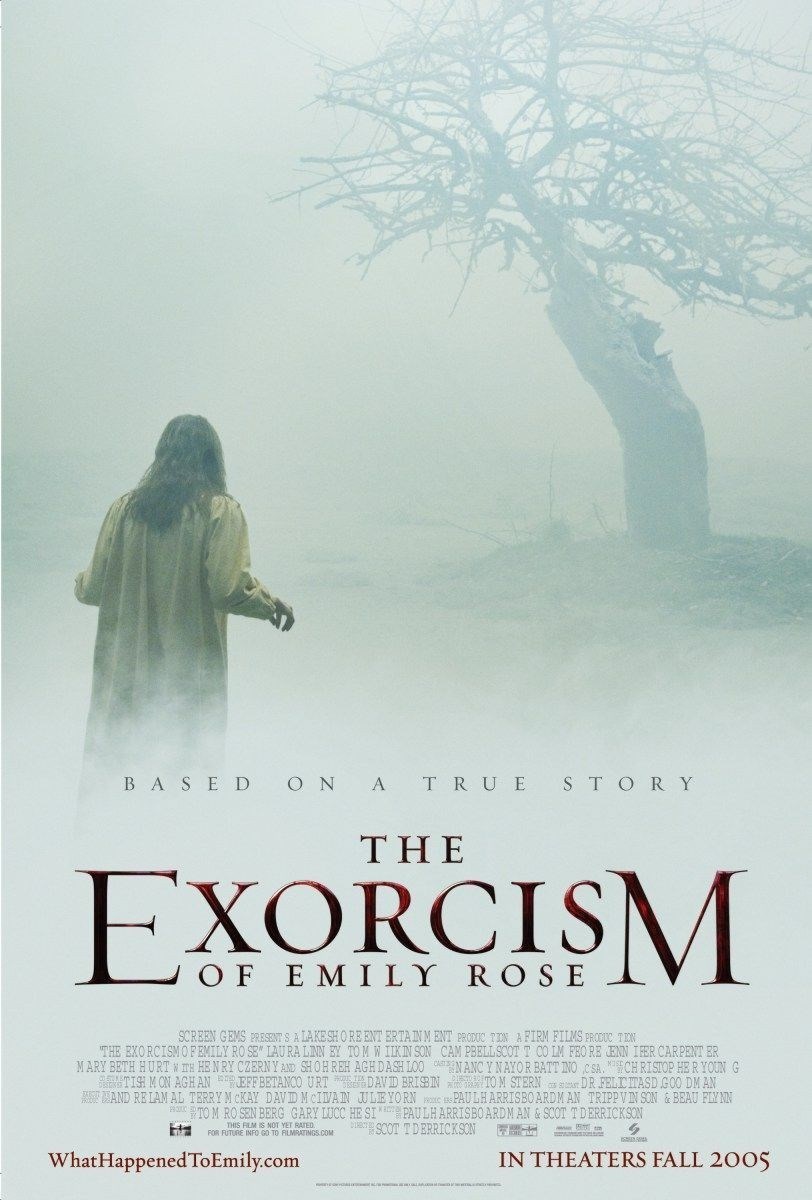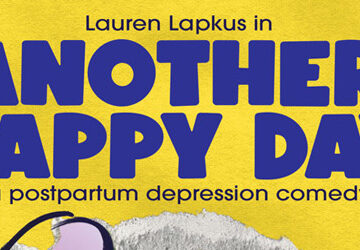In the mid ‘70s, a young German woman named Anneliese Michel underwent the Roman Ritual of Exorcism. In the ten years leading up to the ritual, Anneliese battled a myriad of health issues, both physical and psychiatric. Diagnoses of epilepsy, depression, and a battery of treatments involving anti-seizure medications, mood stabilizers, and antipsychotic drugs did not seem to alleviate her suffering.
Deeply devout Catholics, the Michels sought help in the Church. It did not take long for them to find a priest, Ernst Alt, willing to perform an exorcism, and a bishop, Josef Stangl, who would grant him permission to do so. The ritual lasted for almost a year, but despite the dogged persistence of Father Alt – or because of it, depending on one’s spiritual leanings (or lack thereof) – the results were unfavorable. Anneliese Michel died on July 1, 1976. The cause of death was malnourishment and dehydration.
- Still from The Exorcism of Emily Rose
Anneliese’s tragic story, her slow but devastating decline, and the possibility of the involvement of demonic forces have aroused the curiosity of many, not the least of whom was linguist, author, and anthropologist Felicitas D. Goodman. Goodman wrote a book about Anneliese’s exorcism, the events leading up to it, and the subsequent trial against Father Alt, Bishop Stangl, and Josef and Anna Michel. It is this book, The Exorcism of Anneliese Michel (1980), upon which the 2005 film The Exorcism of Emily Rose is based.
Directed by Scott Derrickson (Deliver Us from Evil 2014, Sinister 2012), who co-wrote the screenplay with Paul Harris Boardman (Deliver Us from Evil 2014, Devil’s Knot 2013), The Exorcism of Emily Rose is an unusual mix of Horror and Courtroom Drama. The protagonist is not Emily herself, but Erin Bruner (Laura Linney: Mr. Holmes 2015), the ambitious lawyer who takes on the case of the fictional Father Moore (Tom Wilkinson: Selma 2014) who, just like the real-life Father Alt, has been charged with negligent homicide. For Father Moore, the outcome of the trial is immaterial; what he really wants is to share Emily’s story.
Jennifer Carpenter (Dexter 2006-2013) plays eighteeen year old Emily, whose story is told in a series of flashbacks as various witnesses relate their testimonies. Excepting her strong devotion to her faith, Emily is characterized as a typical American girl – the screenwriters brought the story to the U.S. – testing the waters of the adult world by going away to college. There, Emily begins a relationship with Jason (Joshua Close: Fargo TV Series 2014) who, although somewhat underdeveloped as a character, offers his patient support to Emily throughout her harrowing experience, and continues to offer his support to her parents in the courtroom. Jason is the only positive to come from Emily’s college experience, however, as it is there that she first begins to experience the influence of the demonic.
The Horror-themed elements of the film occur during the flashbacks that depict Emily’s possession and exorcism, as well as in scenes involving Bruner, which serve to put a dent in her and the viewer’s skepticism. Emily’s experience with demonic entities is one of the more upsetting ones to be put to film, not because it is any more brutal than that of other films, but because the character is so sympathetic. Carpenter offers a strong performance as an innocent under assault, and if viewers cannot empathize with her guileless demeanor, they will at least want her to be safe. Emily has a kind of unassuming purity that is not intended to make others feel corrupt in comparison, but instead serves to elicit a desire to see that purity preserved. When the demons – allegedly there are six of them – begin to impose their depraved influence, viewers will be saddened as well as frightened.
- Still from The Exorcism of Emily Rose
The possession scenes are typical of the genre, but an atmosphere of isolation and the suggestion of mental illness at the beginning of the film makes them frightening regardless of their familiarity. As a Horror movie, however, The Exorcism of Emily Rose does not lend too much credence to the idea that Emily’s plight is the result of a psychiatric disorder, although prosecuting lawyer Ethan Thomas (Campbell Scott: Royal Pains 2009-2015) provides convincing evidence that this is, in fact, the case.
Still, various events surrounding everyone involved, both in the flashbacks and the main narrative, make it quite clear that the “one-two-three-four-five-six” entities Emily refers to are very real and very powerful. To theistic scholars, demonologists, and Horror fans, the names of those entities will be familiar, as will their tendency to wreak havoc at 3 am. The Exorcism of Emily Rose might be one of the first films, if not the first, to provide an explanation for this phenomenon, and after hearing it, viewers will never again feel quite at ease when inexplicably roused at that hour.
The Exorcism of Emily Rose unmistakably takes the side of religion in the argument of psychosis versus demonic possession, however it does not attempt to proselytize. Nonbelievers in the film are not punished, and there is no implication that people need atone for their sins, or start attending church, or accept Jesus into their lives in order to ward off evil. Emily Rose herself is a model Catholic, but she is susceptible to demonic attack in spite of her devotion.
Although the plot is centered around issues of the Catholic Church, the threat of evil is made universal, most notably when Bruner calls an expert witness to the stand, Shohreh Aghdashloo as Dr. Sadira Adani, to attest to the fact that belief in the demonic exists in many cultures and faiths. (It is likely that this character, an anthropologist, is based on the aforementioned Felicitas D. Goodman.)
- Still from The Exorcism of Emily Rose
The Exorcism of Emily Rose is a film worth watching as it certainly stands out in its genre. When it first came out, many Horror fans regarded it as the best film about demonic possession since The Exorcist, and in the fifteen years since its release, there have been few films in that genre that live up to its caliber. Since it is based on a true story, no matter how loosely, it raises an interesting discussion on the relationship between medical science and spirituality, and the ethical dilemmas sometimes associated with allowing either one to trump the other.
For many viewers, it will also call to mind more temporal horrors. The fact is that no matter what viewers believe or disbelieve, Anneliese Michel, the real-life Emily Rose, died during an exorcism. That a young woman could exhibit symptoms so disturbing and so confounding that after a decade of suffering, she and her loved ones conclude that demonic possession is the only explanation; that the ritual of exorcism was performed as recently as the 1970s and is still performed today; and that there are people desperate enough to seek out such a solution should all be reason enough to rattle anyone, whether believer or skeptic. Considering these very real horrors, the emphasis on the demonic in The Exorcism of Emily Rose is just lagniappe.
- Screen Gems









1 Comment